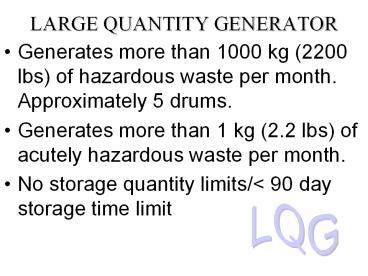LARGE QUANTITY GENERATOR PowerPoint PPT Presentation
1 / 25
Title: LARGE QUANTITY GENERATOR
1
LARGE QUANTITY GENERATOR
- Generates more than 1000 kg (2200 lbs) of
hazardous waste per month. Approximately 5
drums. - Generates more than 1 kg (2.2 lbs) of acutely
hazardous waste per month. - No storage quantity limits/lt 90 day storage time
limit
LQG
2
LQG Requirements
- All of the SQG requirements plus ..
- Do Not Store HW gt 90 Days
- File Quarterly Report for HW generated Shipped
Offsite - Maintain Emergency Equipment
- Expanded Contingency Plan
- Position Descriptions
- Annual Training
3
Step 3 Identifying Waste Streams
- Landscaping/Grounds Keeping
- Pesticide/Herbicide
- Fertilizer
- Rinse water from cleaning equipment
- Maintenance on equipment
4
Laboratories
- Pathology
- Histology
- Microbiology
- Chemistry
- Serology
5
Laboratory Wastes
- Xylene
- Alcohol
- Alcohol/xylene/stain
- Formalin
- Mercury
- Out of date chemicals
6
Radiology
Spent photographic fixer containing silver
7
Pharmacy
- Out of date or damaged drugs
- Chemotherapy waste
8
Fleet Maintenance
- Parts washer / Mineral Spirits
- Carburetor Cleaner
- Brake Cleaner
- Used Oil
- Antifreeze
- Contaminated Rags
- Batteries
9
Other Wastes
- Expired/Off Spec Chemicals, Reagents, Standards
- Lab packs
10
Other Wastes(cont.)
- Miscellaneous
- Broken Thermometers
- Rinsates from cleaning glassware
- Waste pump oil
- Debris contaminated with listed waste
- i.e. chem. wipes and funnels contaminated
- with methylene chloride
- Gram Staining
- Tissue Preservation
11
SO WHAT DO WE LOOK FOR DURING AN INSPECTION?
12
Waste Determination
- Failure to perform hazardous waste determination
and/or a proper waste determination. - Failure to document claims that materials are not
solid wastes (non-hazardous) OR are conditionally
exempt from regulation.
13
Notification
- Failure to notify/obtain an EPA ID number
- Failure to keep emergency information up to date
14
Manifests
- Failure to use a hazardous waste manifest
- Failure to file an exception report (45/60 days)
- Missing or incorrect information on manifest.
- Failure to use a transporter that has a SC HW
registered t-porter. - Failure to retain manifests for 3 years.
- Missing LDR
- Use of old manifest after 9-05-06
15
(No Transcript)
16
Labeling
- Failure to label drums/containers with
- the words Hazardous Waste or
- for satellite accumulation containers
- label with a description of the contents.
- Failure to label each container according to DOT
regulations prior to shipment. - Failure to offer transporter
appropriate placards.
17
Accumulation
- Accumulation beyond the 90(180) day limit.
- Drums/containers not marked with accumulation
start dates. - Accumulation of too much HW on site.
18
Satellite Accumulation
- 55-gallons Maximum
- At or near the Point of Generation
- Labeled Hazardous Waste or
- other Words that Describe Contents
- Mark waste accumulated in excess
- of 55-gallons with the date of accumulation
- 72 hours to move to storage area
19
Container Management
- Open, rusting or bulging drums
- No weekly inspection of containers.
- Storing ignitable waste within 50 feet of
property line. - Failure to maintain aisle
- space between containers.
20
Record Keeping
- Failure to maintain uniform
- manifest or contractual
- agreement for 3 years.
- Failure to retain records of test results, waste
analyses, or waste determinations.
21
Personnel Training
- Failure to conduct training.
- Training does not cover all areas.
- Failure to document training
- conducted.
- Training not completed within
- 6 months of hire date.
- Training is not completed annually.
- Failure to provide job titles, job descriptions,
and names.
22
Preparedness and Prevention
- No arrangements with local authorities.
- Arrangements not documented.
- Failure to have required equipment.
- Failure to maintain and operate facility to
minimize unplanned or sudden release.
23
Contingency Plan/Emergency Procedures
- Failure to have a contingency plan.
- Incomplete or outdated contingency plan.
- Failure to submit a contingency plan to
authorities. - Incomplete reporting after an incident.
- Failure to implement a contingency plan.
- Failure to report emergency incident (assuming
contingency plan was implemented). - Failure of SQG to post information by telephone.
24
Land Disposal Restrictions
- Failure to perform waste analyses prior to
treatment of waste to determine if the waste is
restricted from land disposal (improper disposal
of restricted wastes). - Failure to develop and follow a written waste
analysis plan for on-site treatment of restricted
wastes in tanks or containers. DILUTION of LDR
waste or treatment of residual is not a
substitute for adequate treatment. - Failure to provide or use a LDR with a hazardous
waste shipment. - Failure to retain LDRs and waste analysis data
for 3 years. - Missing or incorrect information on LDR forms.
25
The Process
- Warning Letter
- Inspection Report
- Pictures
- Violations
- Penalties
- Informal Conference
- YOUR chance to respond
- Discussion of alleged violations
- Consent Order
- Formal resolution of informal agreement
- Inspection Report
- Pictures

